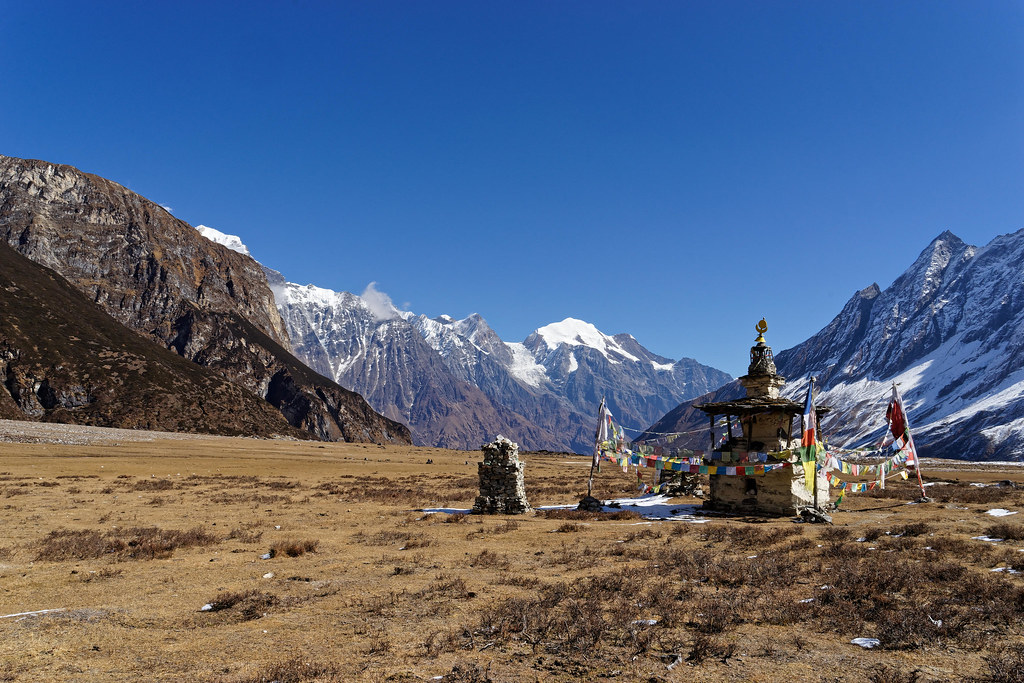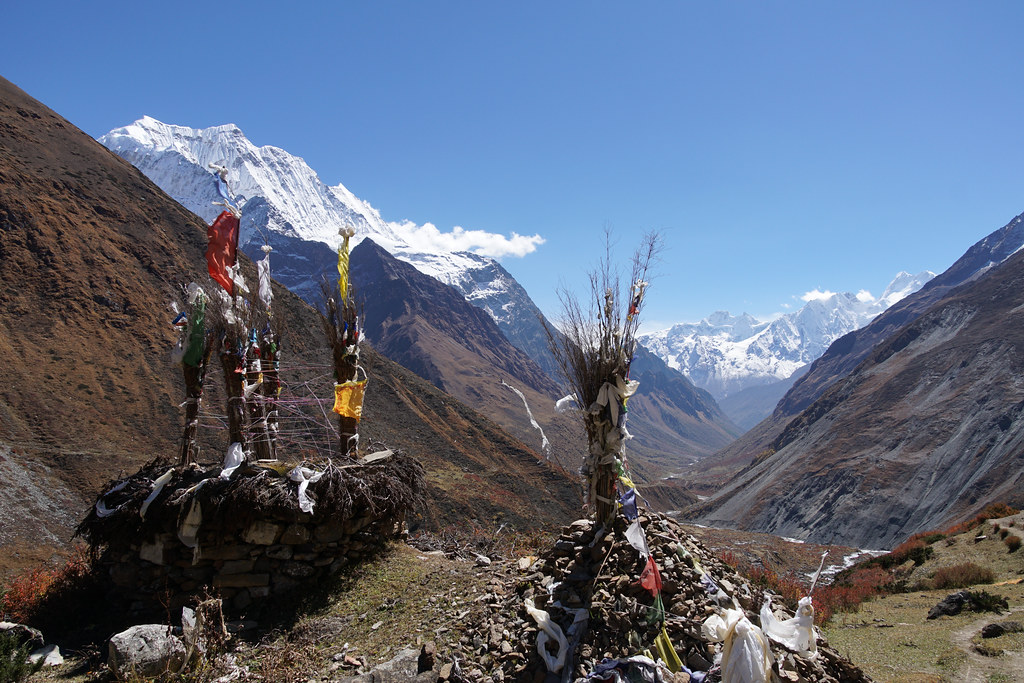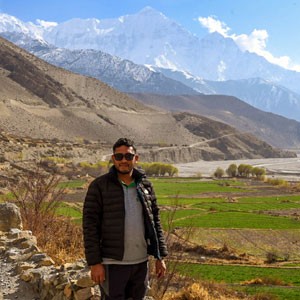Pungyen Monastery (also spelled Pungen Gompa) is one of the most important Buddhist monasteries in the Manaslu region, sitting at about 3,200m above sea level in the village of Deng (Deng Gompa). It’s a key spiritual and cultural waypoint on the Manaslu Circuit trek, offering trekkers a chance to see traditional Tsum Valley and Tibetan‐influenced Buddhist architecture, practice, and art.
Pungen Gompa is a small Tibetan Buddhist monastery tucked into the high hills of Nepal’s Manaslu region. You won’t find it on a paved road it perches at roughly 4,000 meters (about 13,000 feet) on a ridge between two tiny villages called Samagoun and Shyala. Most trekkers first reach Samagoun (a quiet village at around 3,500 meters), then follow a rocky path that climbs about 500 meters over a few hours until they arrive at the Gompa.
Along the way, prayer flags flutter overhead and distant peaks of Manaslu loom into view. From the monastery’s simple courtyard, you can see glaciers and snowfields stretching up toward the main summit of Manaslu itself. In other words, if you picture a remote spot where prayer wheels’ spin in the chilly mountain breeze and monks chant at dawn, you’ve got the essence of Pungen Goma’s setting. It’s part of the Manaslu Circuit Trek in Gorkha District, and there’s no road just paths carved into hillsides, yak pastures, and the occasional cluster of stone houses. Below are some details to help you appreciate and plan a visit:
Pungyen Gompa Location & Approach
Pungyen Monastery perches slightly above Deng, which itself lies on the west bank of the Budi Gandaki River. Deng is the last sizable village before you head up toward Namrung and Larky La. If you’ve taken a side trip into Tsum Valley, you’ll rejoin the main Manaslu Circuit trail here, and Pungen is one of the first Gompas you’ll encounter on the return. If you’re trekking the classic Manaslu Circuit, you’ll typically arrive in Deng on Day 5 or 6 (after Namrung and before Namrung Pass), depending on your itinerary.
From the main trail through Deng, a short stone‐walled path branches off and winds up to the Gompa in about 10–15 minutes. There are prayer flags and small mani walls marking the way. Because Deng sits in a narrow valley, the ascent to Pungen feels like a sudden lift out of the river gorge.

Historical & Cultural Significance
Pungen ( Pungyen) Gompa was founded in the 18th century by a Tibetan lama of the Gelugpa order. Over time it became a center for both local villagers and pilgrims coming from Tibet or other parts of the Himalaya. It remains affiliated with the same lineage that runs several larger monasteries around Lasha (Shigatse) and Rongbuk in Tibet.
Historically, Pungyen served as a major religious hub for both Tsum Valley and the upper Manaslu valley. Monks from here would lead ceremonies in smaller Tsum villages, and families from Tsum would pilgrimage to Pungen once a year, especially during Losar (Tibetan New Year) or Saga Dawa (Buddha’s birth, enlightenment, and passing festival).
Like many Himalayan monasteries, Pungen has local legends some villagers still speak of a “Yeti scalp” or “Yeti hair” once kept here, though these relics have largely disappeared or been moved for preservation. Still, you may hear animated stories from older villagers about how the gompa walls faintly shake during winter winds, believed by some to be “Yeti breath.”
Architectural Highlights
Main Prayer Hall (Du-khang) is painted in deep reds and ochres, the interior houses several large gilt‐bronze statues: a three‐meter‐high Buddha Shakyamuni in the central shrine, flanked by Avalokiteshvara and Guru Rinpoche (Padmasambhava). Bright “Thanka” scrolls depicting the Wheel of Life and mandalas cover the back wall.
Chortens & Mani Walls: Just below the Gompa is a whitewashed, cylindrical chortens (dhvajas) where locals spin prayer wheels around its base. Mani walls (rows of inscribed stone tablets) line the path each featuring the mantra “Om Mani Padme Hum” carved in Tibetan script. Devotees stop to spin or recite as they ascend.
Monastic Quarters: Behind the main hall you’ll see a cluster of simple stone‐and‐timber living quarters for resident monks. Roofs are pressed with yak “khaps” (grass and soil mixtures) to insulate against cold. In spring and autumn, monks use the rooftop yards to sun‐dry prayer flags and ritual scarves (khatas).
Library & Scriptures: A small side room off the main hall stores ancient leaf‐book texts (pecha) wrapped in cloth, books of Vinaya (monastic code), Abhidharma (philosophical teachings), and Vinaya‐Mula Satra. Occasionally a visiting lama will give teachings here, and it’s considered auspicious for trekkers to pause at the library entrance, spin the wooden prayer‐wheel stand there, and bow thrice before entering.
Best Time to Visit & Festivals
Manaslu Circuit Window (September–October, March–April): Though Deng and Pungen lie at a relatively moderate altitude, spring and autumn bring clearer skies and easier trail conditions. Winter snows can close this section from December to February.
Losar Celebrations (Late February/March): If your trek coincides with Tibetan New Year, you’ll witness monks performing cham (mask‐dance) rituals in the courtyard, dressed as wrathful deities, they circle the chorten with drums and cymbals, believed to clear negative energies for the coming year.
Saga Dawa (May/June): This is the holiest month in the Tibetan‐Buddhist calendar. Monks at Pungen host special prayer‐service mornings, inviting trekkers to join in mantra recitation. It’s a spiritually charged atmosphere, though there’s often a modest entrance donation requested.
Local Pilgrimage Periods (Sept 15–Oct 15): Outside of big festivals, villagers from Tsum and Larke make pilgrimages to give offerings or seek blessings for a good harvest season. During these weeks Pungen can be busier than usual, if you prefer solitude, aim to pass through in mid October.
Visiting Etiquette & Tips
Dress & Behavior
- Remove hats/caps before entering the prayer hall.
- Speak in hushed tones or remain silent when inside; conversations and photography near the main shrine should be avoided during prayer times.
- Sit cross‐legged on the floor, if space allows, rather than standing or hovering near the shrine.
Donations & Offerings
- There’s usually a wooden donation box just inside the entrance. Even a small amount (100–200 NPR) is appreciated for upkeep and monk stipends.
- If you want to offer khatas (white ceremonial scarves), bring one from home or purchase in Deng; you’ll see local stall vendors selling khatas in packs of three.
Photography & Respect
- Ask permission before taking photos of monks, especially during rituals.
- Flash is discouraged inside the hall because it can degrade old thanka pigments. Use natural light only, or shoot from the doorway if sunlight filters in.
Listening & Learning
- If you hear chanting, sit quietly at the back. Monks may repeat mantras in Tibetan at break times, if you’re curious, you can gently ask a senior monk for the meaning, but be prepared for a language barrier (most speak only Tibetan or Sherpa).
Timing Your Visit
- Early morning (around 7 am) is best if you want to see monks chanting, since they often finish by 8 am and head off to their quarters.
- Late afternoon (4–5 pm) is good for a quieter experience, most visitors have moved on, and monks do informal study in smaller groups.
How It Fits into Your Trek & Nearby Facilities
Overnight Stay Options in Deng
While many trekkers use Deng just as a high‐energy “stopover” to rest and eat, you can spend a night or two here if you want to explore local culture. Deng has several teahouses with basic rooms (wooden bunks, 1–2 thin blankets) with shared bathrooms. Electricity may be sporadic, powered by micro‐hydro, so bring a power bank.Meals focus on dal bhat, noodle soups, and cornmeal porridge. If you have dietary restrictions, carry some instant foods or your own seasoning.
Acclimatization Considerations:
Deng’s elevation (3,200m) makes it a sensible spot for your first rest day after leaving Namrung (3,410m) or as you prepare for the climb to Namrung La (3,858m). Although it’s not strictly a “mandatory” acclimatization stop, spending an extra night here can help reduce fatigue and stave off mild altitude headaches.
Continuing the Manaslu Circuit:
From Deng, your trail splits: one branch heads toward Sama Gaun and the Tsum Valley diversion (north); the main Manaslu Circuit continues eastward toward Namrung. Be sure you’re on the correct fork if you’ve already explored Tsum Valley. If you’re looping around via Tsum and rejoining in Deng, plan at least one full day here visit Pungen in the morning, rest in the afternoon, and be ready for early departure the next day.

Why Pungen Gompa Is Worth Your Time
Far from the crowds of Annapurna or Everest regions, Pungen Gompa lets you see how local villagers (mostly Gurung, Sherpa, and ethnic Tibetan families) integrate monastic life into daily routines farmers will pause in the fields to spin prayer wheels, and children often walk past the chorten wearing prayer mala beads.
It is one of the Scenic Vantage Point as from the courtyard of Pungen, you get sweeping views of the upper Budi Gandaki gorge, with the snow capped ridge of Himalchuli rising to the west. On a clear day, you can also glimpse peaks like Cheo Himal and Baudha (Boudha) Himal farther north. It’s a quieter, less photographed view than the Everest panoramas, but no less spectacular.
Even a brief visit, standing before the main gilded Buddha, lighting a butter lamp (often around 20 NPR each), or spinning the large prayer wheel outside can feel like a reset before tackling the more arduous climbs ahead (especially crossing Namrung La at nearly 3,860 m). Many trekkers speak of the sense of calm that washes over them here, as if they’ve left the hustle of the lower valleys behind.
Required Permits to Pungyen Gompa (Monastery) Visit
To reach Pungen Gompa, you’ll need to sort out a few official documents before you set foot on the trail:
Manaslu Restricted Area Permit
Since Pungen Gompa sits inside the special “restricted” zone of the Manaslu region, every non-Nepali trekker must hold this permit. In the quieter months (December through August), the fee is roughly US $75 for the first week and about US $10 for each extra day. During the busier trekking months (September through November), expect to pay around US $100 for seven days plus US $15 per additional day. You cannot obtain this permit on your own at the trailhead; a registered Nepali trekking agency will apply on your behalf, submitting your passport copy, photos, and chosen dates to the Department of Immigration in Kathmandu.
Manaslu Conservation Area Permit
On top of the restricted-area permit, there’s a flat fee to help protect local forests, wildlife, and villages. Foreign visitors pay about NPR 3,000 (around US $22), regardless of how long they stay. Citizens of SAARC countries to pay NPR 1,000. Your trekking agency will arrange this at the same time it handles the restricted-area permit.
TIMS Card
In most of Nepal, you’d need a TIMS (Trekkers’ Information Management System) card, but inside Manaslu’s restricted section it’s generally not enforced. Your agency will confirm whether any permit office along the route requests it, but as of early 2025, you can assume TIMS isn’t mandatory for the Manaslu Circuit.
Group and Guide Requirements
The Manaslu region does not allow solo trekking once you enter that restricted corridor. You must travel with at least one other person and have a licensed guide who carries a copy of your permits. Agencies coordinate guide assignments and will ensure the paperwork is checked at the main checkpoints (Jagat and near Samagaun).
Extra Local Fees (If You Venture Off the Main Path)
For a straight shot between Soti Khola, Samagaun, Pungyen Monastery, and Shyala, the restricted-area and conservation-area permits are all you need. However, if you detour into places like Tsum Valley or head toward very local villages under Chum Nubri Rural Municipality, there can be an additional municipal permit costing roughly US$ 30–40 for a week, plus a small daily top-up. Pungyen Gompa itself doesn’t trigger that extra fee, but it’s good to know you might encounter it if your route shifts.
Conclusion
Pungyen Gompa in the Manaslu region is not just an architectural stop, it’s a living hub of Himalayan Buddhism that you’ll remember long after your Manaslu trek. Tucked into the walls of Deng’s steep-sided valley, its chortens, prayer wheels, and ancient statues offer insight into centuries of spiritual practice.
Whether you’re taking photographs of the gilded Buddha, listening to monk’s chant at dawn, or simply pausing to spin a prayer wheel against a backdrop of towering peaks, a visit here can ground your entire Manaslu journey in a deeper cultural and historical context.
If your itinerary allows even a short layover in Deng, make time to walk up to Pungyen Monastery those fifteen minutes of uphill from the river valley might become one of the most memorable parts of your trek. Keep both permits (and copies) handy: officials check them in Jagat and again near Samagaun. Beyond that, all you need to do is travel in a group of two or more with a licensed guide, and you’re set to hike up from Samagaun to Pungen Gompa at about 4,000 meters without any extra hurdles.

